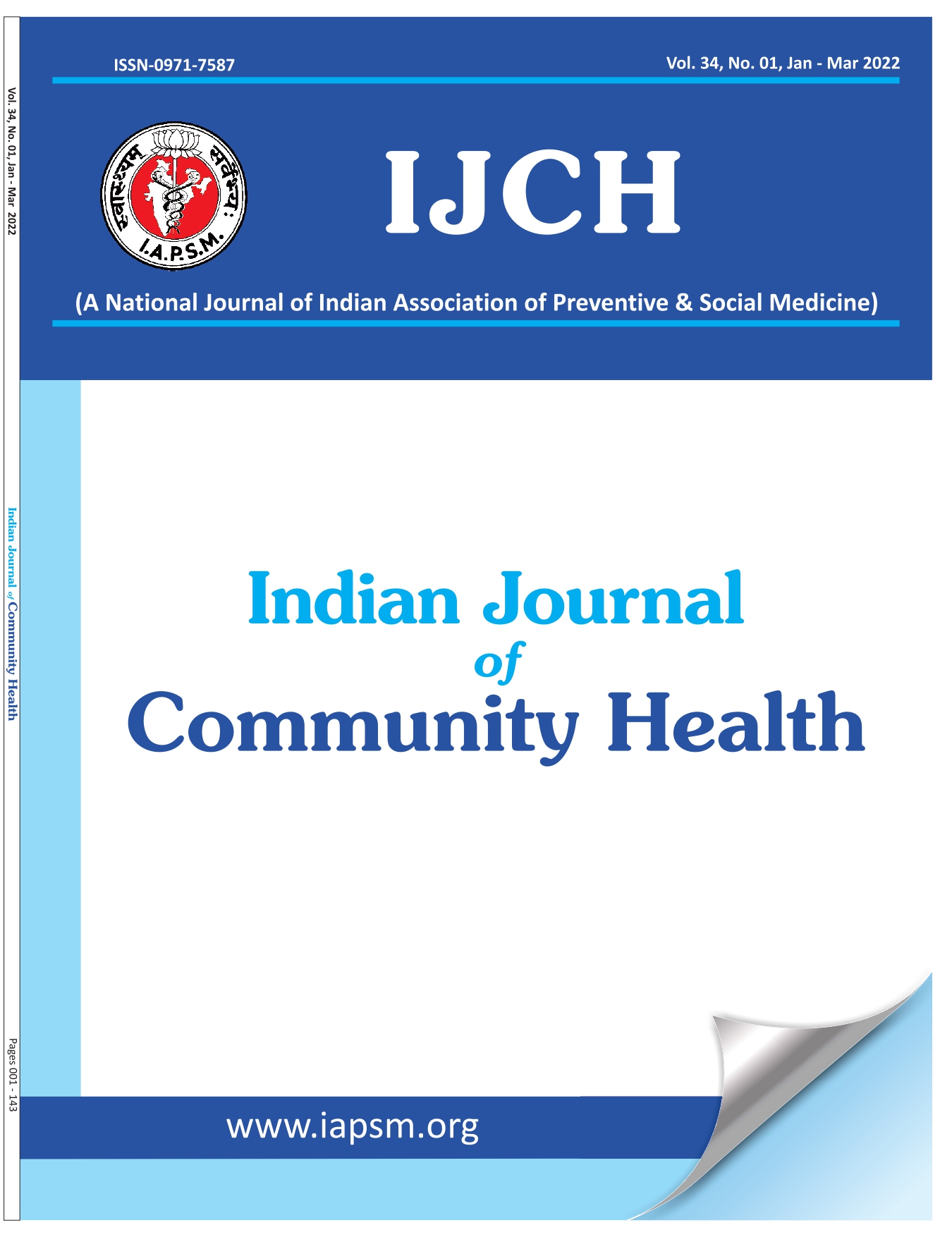Profile of Multi Drug Resistant Tuberculosis patients: A Study at Drug Resistant Tuberculosis Centre in Kumaun Region, Uttarakhand
DOI:
https://doi.org/10.47203/IJCH.2020.v32i04.007Keywords:
Drug Resistant Tuberculosis (DR-TB) Centre, Multi Drug Resistant Tuberculosis (MDR-TB)Abstract
Background: Drug Resistant Tuberculosis (DR-TB) has frequently been encountered in India, and its presence has been known virtually from the time anti-TB drugs were introduced for the treatment of Tuberculosis. Multi Drug Resistant Tuberculosis (MDR-TB) is a man-made phenomenon and has become a formidable challenge to effective Tuberculosis control in India. Objectives: To study the Socio-demographic and Clinical profile of Multi Drug Resistant Tuberculosis (MDR-TB) patients presenting to Drug Resistant Tuberculosis (DR-TB) Centre at Govt. Medical College, Haldwani in the Kumaun region, Uttarakhand. Methodology: This study is a Record based study, where in service data available at Drug Resistant Tuberculosis (DR-TB) Centre at Govt. Medical College, Haldwani in the Kumaun region, Uttarakhand, was accessed and analyzed. Inclusion criteria included all patients with diagnosis of Multi Drug Resistant Tuberculosis (MDR-TB) presenting to the centre from 1st April 2015 to 31st December 2015. Results: The present study showed that younger age group particularly males were more affected with MDR-TB. Under-nutrition was quite prevalent among the MDR-TB patients. 56.7% cases were addicted to alcohol and 54.3% cases were addicted to smoking. 85.8% patients took treatment for TB and 44.1% not completed their treatment. Relapse of previous anti-tuberculosis treatment was found to be the major contributor in MDR-TB suspect cases. Prevalence of XDR-TB was also found to be low. Conclusion: The findings of the study emphasize the importance of studying the socio-demographic factors and baseline clinical characteristics in different MDR-TB patient categories to timely modify and strengthen the national programs.
Downloads
References
Barberis I, Bragazzi NL, Galluzzo L, Martini M. The history of tuberculosis: from the first historical records to the isolation of Koch's bacillus. J Prev Med Hyg. 2017;58(1):E9-E12. PMID: 28515626; PMCID: PMC5432783.[PubMed].
Alexander PE, De P. The emergence of extensively drug-resistant tuberculosis (TB): TB/HIV coinfection, multidrug-resistant TB and the resulting public healththreat from extensively drug-resistant TB, globally and in Canada. Can J Infect Dis Med Microbiol. 2007;18(5):289-91. doi: 10.11552007/986794. PMID: 1893728; PMCID: PMC2533560.[PubMed].
Drug-resistant tuberculosis - WHO. [Cited on 2020 Dec 4]. Available from: https://www.who.int/tb/areas-of-work/drug-resistant-tb/en/
Global tuberculosis report 2019 - WHO. [Cited on 2020 Dec 8]. Available from: https://www.who.int/tb/publications/global_report/en/
Drug-resistant TB: XDR-TB FAQ - WHO. [Cited on 2020 Dec 12]. Available from: https://www.who.int/tb/areas-of-work/drug-resistant-tb/xdr-tb-faq/en/
Sharma SK, Mohan A, Kadhiravan T. HIV-TB co-infection: epidemiology, diagnosis & management. Indian J Med Res. 2005 Apr;121(4):550-67. PMID: 15817963.[PubMed]
TB Alliance - Envisioning a world without TB·[Cited on 2020 Dec 22]. Available from: www.tballiance.org/
Prasad R, Singh A, Balasubramanian V, Gupta N. Extensively drug-resistanttuberculosis in India: Current evidence on diagnosis & management. Indian J MedRes. 2017;145(3):271-293. doi: 10.4103/ijmr.IJMR_177_16. PMID: 28749390; PMCID: PMC5555056.[PubMed].
Central TB Division, Directorate General of Health Services, Ministry of Health and Family Welfare. Guidelines on programmatic management of drug resistant tuberculosis (PMDT) in India. NirmanBhavan, New Delhi: Revised National Tuberculosis Control Programme; 2012:18-29.
Paramasivan CN, Venkataraman P. Drug resistance in tuberculosis in India. Indian J Med Res. 2004 Oct;120(4):377-86. PMID: 15520487.[PubMed]
Ramachandran R, Nalini S, Chandrasekar V, Dave PV, Sanghvi AS, Wares F, Paramasivan CN, Narayanan PR, Sahu S, Parmar M, Chadha S, Dewan P, Chauhan LS. Surveillance of drug-resistant tuberculosis in the state of Gujarat, India. IntJ Tuberc Lung Dis. 2009;13(9):1154-60. PMID: 19723407.[PubMed].
Paramasivan CN, Rehman F, Wares F, Sundar Mohan N, Sundar S, Devi S, Narayanan PR. First- and second-line drug resistance patterns among previously treated tuberculosis patients in India. Int J Tuberc Lung Dis. 2010;14(2):243-6. PMID: 20074419.[PubMed].
Datta BS, Hassan G, Kadri SM, Qureshi W, Kamili MA, Singh H, Manzoor A, Wani MA, Shamas-u-Din, Thakur N. Multidrug-resistant and extensively drug resistant tuberculosis in Kashmir, India. J Infect Dev Ctries. 2009 Nov 21;4(1):19-23. doi: 10.3855/jidc.669. PMID: 20130374.[PubMed].
Udwadia ZF, Moharil G. Multidrug-resistant-tuberculosis treatment in the Indian private sector: Results from a tertiary referral private hospital in Mumbai. Lung India. 2014;31(4):336-41. doi: 10.4103/0970-2113.142101. PMID:25378840; PMCID: PMC4220314.[PubMed].
Dholakia YN, Shah DP. Clinical profile and treatment outcomes of drug- resistant tuberculosis before directly observed treatment strategy plus: Lessons for the program. Lung India. 2013;30(4):316-20. doi: 10.4103/0970-2113.120608. PMID: 24339490; PMCID: PMC3841689.[PubMed].
Sharma SK, Kumar S, Saha PK, George N, Arora SK, Gupta D, Singh U, Hanif M, Vashisht RP. Prevalence of multidrug-resistant tuberculosis among category IIpulmonary tuberculosis patients. Indian J Med Res. 2011 Mar;133(3):312-5. PMID: 21441686; PMCID: PMC3103157.[PubMed].
Gupta S, Bandyopadhyay D, Gupta S, Sadhukhan S, Banerjees S. A sociodemographic study of multidrug resistant tuberculosis cases from DOTS clinics of Kolkata. J Indian Med Assoc. 2012;110(10):723-5. PMID: 23738405.[PubMed].
Mukherjee P, Prasanta Ray Karmakar P R, et al. Sociodemographic and clinical profile of multi drug resistant tuberculosis patients: a study at drug resistant tuberculosis centers of Kolkata. IOSR- J Dent Med Sci 2015; 14(8):52-8
Azhar GS. DOTS for TB relapse in India: A systematic review. Lung India. 2012;29(2):147-53. doi: 10.4103/0970-2113.95320. PMID: 22628930; PMCID: PMC3354489.[PubMed].
Sethi S, Mewara A, Dhatwalia SK, et al. Prevalence of multidrug resistance in Mycobacterium tuberculosis isolates from HIV seropositive and seronegative patients with pulmonary tuberculosis in north India.BMC Infectious Diseases.2013; 13:137. doi: 10.1186/1471-2334-13-137.
Sharma SK, Mohan A, Kadhiravan T. HIV-TB co-infection: epidemiology, diagnosis & management. Indian J Med Res. 2005;121(4):550-67. PMID: 15817963.[PubMed].
World Health Organization. TB/HIV: a clinical manual. Available from: http://whqlibdoc.who.int/publicatio ns/2004/9241546344.pdf
Sungkanuparph S, Eampokalap B, Chottanapund S, Thongyen S, Manosuthi W. Impact of drug-resistant tuberculosis on the survival of HIV-infected patients. Int J Tuberc Lung Dis. 2007;11(3):325-30. PMID: 17352100.[PubMed].
World Health Organization. Global tuberculosis report 2014. [Internet] [cited 2015 May 27 ]. Available from: http://apps.who.int/iris/bitstream/10665/137094/1/9789241564809_eng.pdf
Porwal C, Kaushik A, Makkar N, Banavaliker JN, Hanif M, Singla R, Bhatnagar AK, Behera D, Pande JN, Singh UB. Incidence and risk factors for extensively drug-resistant tuberculosis in Delhi region. PLoS One. 2013;8(2):e55299. doi: 10.1371/journal.pone.0055299. Epub 2013 Feb 4. PMI: 23390524; PMCID: PMC3563594.[PubMed]
Downloads
Published
How to Cite
License
Copyright (c) 2020 Indian Journal of Community Health

This work is licensed under a Creative Commons Attribution-NonCommercial-NoDerivatives 4.0 International License.





